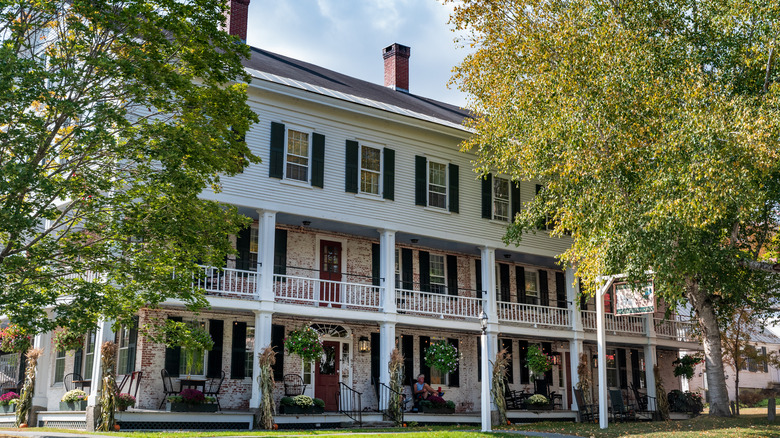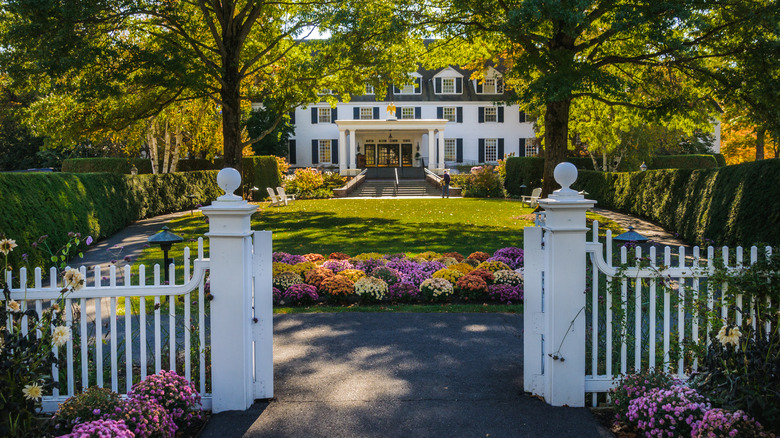5 Vermont Towns With Vintage-Style Homes And Historic New England Charm
Vermont is many things. It's New England charm at its finest, the sweet smell of fresh maple syrup candy, and a jar of homemade jam waiting for you at a cozy bed-and-breakfast. It's breathtaking road trip routes lined with hundreds of historic covered bridges, and fiery fallen leaves blanketing dramatic fall foliage. Even though it's landlocked, Vermont surprises with dozens of islands across Lake Champlain, the sixth-largest freshwater lake in the country. It also boasts some of the East Coast's snowiest mountains, especially around Okemo and Stowe. But where this state really shines is in its peaceful towns with vintage-style homes. While there are countless worth visiting, these five villages represent a snapshot of the many charming New England towns in Vermont.
The state has a serious reputation for its fall foliage and autumnal color palette, thanks to the (ironically named) Green Mountains and expansive forests that cover about 78% of Vermont's landscape. To put that into perspective, that's roughly 4.5 million acres of forests stretching across mountains, wrapping around freshwater islands, and surrounding the state's 800-plus lakes.
And with so much of the state blanketed in forests, it's no wonder the internet is overflowing with information about Vermont's exquisite natural beauty and opportunities for outdoor experiences. For the purpose of this article, we'll be narrowing our focus to five New England towns and their historic architecture. Of course, we'll still throw in some of the most exciting outdoor adventures around each one. Chances are, even a trip focused on Vermont's vintage interiors and historic architecture will include a bit of nature at some point.
Stowe
Stowe is often associated with adventure and adrenaline sports. Home to Vermont's tallest mountain and one of its most famous ski areas, that reputation is by no means incorrect. This part of the northern Green Mountains accumulates a solid base layer of winter snow — often enough to stick around well into spring. It's one of the busier towns in the state, but for good reason. There are few sights as quintessentially New England as Stowe's 1863 white church, its 170-foot steeple framed by a Green Mountain backdrop. Its beauty lies in its minimal simplicity, a common feature of New England architecture.
What started as a rural agricultural village has since blossomed into a ski resort town with a village that still holds onto its 19th-century vintage-style architecture. A stroll through the historic downtown reveals Greek Revival and Federal-style buildings, with the iconic Green Mountain Inn at its heart. Dating back almost 200 years to 1833, this inn is no doubt one of the best places to stay in Stowe. It features more than 100 rooms, each elegantly restored to retain its vintage look, reflecting the property's past as a farm, a railroad company office, and accommodation visited by more than one U.S. president. The inn is just one of over 160 historical buildings in downtown Stowe, most of which were built between the early 1800s and 1900s.
If you want to experience Stowe's history and nature without exerting too much energy, follow the 7-mile Stowe Recreation Path. For a bit more of a challenge, take a mountain bike up Cady Hill. If you want all the views but none of the effort, drive the Mt. Mansfield Toll Road, a winding route with gorgeous views of the Stowe Valley.
Bennington
Bennington is best known for its role in the Revolutionary War. Today, visitors can honor the 1777 Battle of Bennington at the 306-foot monument, which shares structural similarities with the Washington Monument. But war history isn't the only thing this town is recognized for.
Founded in 1749, Bennington is officially Vermont's oldest town, with a walkable downtown lined with 18th-century houses and historical buildings. Like many classic New England towns, one of its most recognizable structures is the Old First Church. Another standout, the 35-room Park McCullough Governor's Mansion is a Victorian-era home built in 1865 following the French Second Empire architectural style. Now a museum, this building opens to the public in the spring and is often hired out for private events. A quick browse through local real estate listings reveals just how many historic homes are tucked along the tree-lined streets of Old Bennington. One example is a 1787 Colonial home where vintage wooden beams meet modern kitchen joinery. Another is a French Provincial manor house built in 1866 – both listed on the real estate market as of this writing. One of the oldest homes in Vermont, the William Henry House is a Georgian gem that has stood proudly in Bennington since 1769. It's now a part of the Preservation Trust of Vermont, an organization dedicated to protecting historic buildings across the state.
Cradled by the Green Mountains and Taconic Mountains, Bennington is surrounded by rural farmland and forests. For a place that feels like it belongs in a black-and-white film, it's surprisingly accessible — only three and a half hours from New York City, and about three hours from Boston.
Grafton
Once a sheep farming hub, Grafton is one of the best-preserved villages in New England. Its long history of hospitality dates back to the 1800s, when it served as a stagecoach stop for carriages en route to New York. After about a century as a bustling transit hub, the town fell into decline, only to be restored by the Windham Foundation in the 1960s. Today, fewer than 700 people call Grafton home. The foundation continues to preserve nearly every remaining building, including the general store and the Grafton Inn, which still welcomes guests.
Back in the day, most visitors passing through the town would stay at the Grafton Inn, a boutique hotel filled with antiques and vintage-inspired interiors. Still operating today, the inn remains the heart of this small town, featuring a fine-dining restaurant and a cozy pub called the Phelps Barn Pub. One guest complimented the inn's authenticity, writing, "Its [sic] impeccably maintained, true to its historic heritage, comfy spacious rooms, on point service, delicious meals." Another historic place to stay, the Woodard House is a restored 1800s farmhouse now listed as a self-catering vacation home on Airbnb. With three bedrooms and space to sleep up to eight guests, it's a great option for larger families who want to stay in a piece of Grafton history.
Other than its stagecoach past, Grafton today is centered around one main street with no traffic lights – or traffic, for that matter. What it offers instead is a collection of beautifully preserved homes and buildings, most dating back two hundred years. The most popular way to spend your time here include relaxing by the fireplace at the original inn or exploring the color-coded trails of Grafton Village Park.
Chester
Chester — not to be confused with the nearby town of Manchester — has been working its way into locals' hearts since 1754. Sometimes dubbed Vermont's quaint "Antique Capital," this little town is best known for its distinctive stone houses that date back to the 1830s. Thanks to a local granite quarry, Chester became one of the few towns in Vermont where this unique architectural style took off. Mostly concentrated in a neighborhood known as Stone Village, these homes — built in the symmetrical Greek Revival style – are so distinctive that the area holds a special place on the National Register of Historic Places.
Chester also features a more traditional New England main street, originally centered around a railroad hub known as the Chester Depot. Today, the area is dotted with antique shops, auctioneers, and private galleries. Visitors have a few options when it comes to accommodation. Franklyn Farm Inn, built in the late 1700s, was the town's original stagecoach stop — and still operates as a historic inn today. The Chester Inn, built in 1780, is another authentic New England boutique hotel with just seven rooms, while Motel in the Meadow offers more affordable lodging with a distinctly Americana twist.
In terms of operational businesses, Chester has a decent share of delis, bakeries, and pubs for a small town of just over 1,000 residents. From the restaurant at Fullerton Inn to the 1940s-era Country Girl Diner, to the Heritage Deli and Bakery with antique wooden chairs, and MacLaomainn's Scottish Pub, there is no shortage of places to eat around here.
Woodstock
More often than not, Woodstock is the first town travelers are drawn to when visiting New England. The village is a perfect example of a quintessential Vermont town – consistently named America's most beautiful town and the official "shire town" of Windsor County. Some describe Woodstock as a Norman Rockwell-esque community, a compliment to both the idealist American painter and the beauty of the town. And for good reason. Beginning in the late 1700s, Woodstock was a major hub for business, trade, and art, before evolving into a tourist center with the arrival of the Woodstock Railway in the late 19th century. At the time, it was among the largest and wealthiest towns in Vermont.
Much of that old boomtown charm remains intact today. The elegant Woodstock Inn & Resort and The Shire Woodstock cater to travelers looking for higher-end accommodations. The town has beautifully maintained its 200-year-old homes, buildings, and covered bridges — around ten in total. The most famous, the Middle Covered Bridge, sits right in the heart of downtown. Other notable landmarks include the Norman Williams Public Library, a pink-tinged quartzite building dating back to 1883; Gillingham's General Store, which has been selling essentials since it opened in 1886; and the Woodstock Town Hall Theatre, still hosting cultural events today.
For a taste of the New England countryside, the Marsh-Billings-Rockefeller National Historic Park holds the title of being the first — and only — national historical park in Vermont. The visitor center is a great place to learn about how nature conservation has evolved in the area. You can choose to explore more than 25 miles worth of carriage trails on your own, or join a guided ranger-led tour.





